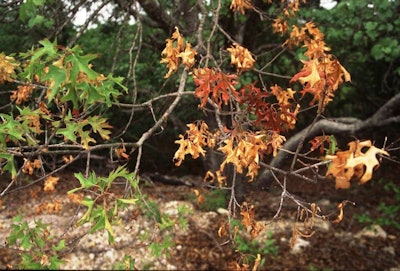 Oak wilt in red oaks can be hard to spot, but leaves often turn pale green and then brown. They remain on the tree for a period of time.
Oak wilt in red oaks can be hard to spot, but leaves often turn pale green and then brown. They remain on the tree for a period of time.Photo: Texas A&M Forest Service
The deadly disease oak wilt has made a second appearance in New York, this time in the Central Islip area of the town of Islip on Long Island.
The discovery was confirmed when a tree care professional submitted samples of four oak trees that showed symptoms of the disease to the Cornell Plant Disease Diagnostic Clinic. After being alerted that the trees tested positive, the tree care professional destroyed the infected trees.
This is the second location in New York that oak wilt has been found. The first infestation was found in Schenectady County in 2008 and 2013.
In response to this small outbreak, the New York State Department of Environmental Conservation (DEC) will initiate the eradication protocols that were used in Schenectady County to control the incurable disease.
A protective zone prohibits the removal of any living, dead, standing, cut or fallen oak trees, or any portion thereof, including branches, logs, stumps or roots, green oak lumber and firewood from the immediate area unless it has been chipped to less than one inch in two dimensions.
Also a 150 foot “red oak free zone” will be established around where the original infected oaks were found. All red oaks in this zone will be destroyed by DEC to prevent the spread, as red oaks are the most susceptible species.
“The infestation is small and isolated, making an aggressive eradication response warranted and feasible to address this serious disease,” said DEC Commissioner Basil Seggos in a press release. “Additional oak trees will need to be removed in the immediate infected area to stop oak wilt in its tracks.”
DEC will conduct both aerial and ground surveys in the coming weeks to calculate how many trees will have to be removed. Property owners with trees that must be removed will be contacted and given information on preventing further infection.
A public meeting will be held to discuss concerns and questions about the methods. DEC expects tree removal to take place during the next six months and will take additional oak samples to determine if further action is necessary to contain the spread.
“Acting now, while the incident is isolated, is a critical step toward preventing the spread of oak wilt and saving our trees,” said state Agriculture Commissioner Richard A. Ball. “This aggressive plan will protect additional trees from infection and help eradicate the infestation quickly.”
Individuals who believe an oak tree is infected are encouraged to contact the Forest Health Information Line at 1-866-640-0652.











